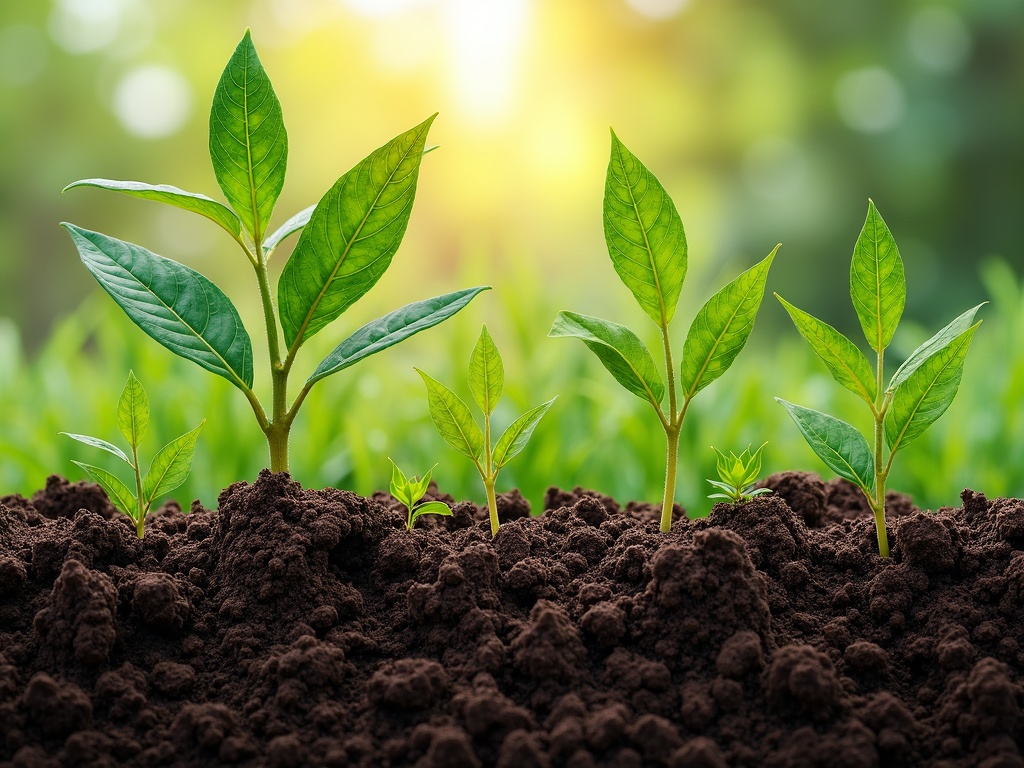Decoding the Earth: Recognizing the Signs of Unhealthy Soil
Imagine your garden as a living, breathing entity. Lush foliage, vibrant blooms, and bountiful harvests are the outward signs of its vitality, all stemming from the hidden world beneath our feet: the soil. But what happens when this vital foundation is compromised? Just as a doctor looks for symptoms to diagnose a patient, gardeners and homeowners need to learn to recognize the **signs of unhealthy soil**. Neglecting these warning signals can lead to stunted growth, pest infestations, and ultimately, barren landscapes.
The Foundation of Life: Why Soil Health Matters
Soil isn’t just dirt; it’s a complex ecosystem teeming with life. Billions of microorganisms, fungi, insects, and earthworms work in harmony to break down organic matter, cycle nutrients, and create a structure that supports plant growth. Healthy soil acts like a sponge, retaining water and releasing it slowly to plant roots. It also provides essential nutrients, like nitrogen, phosphorus, and potassium, that plants need to thrive.
When soil becomes unhealthy, this delicate balance is disrupted. The consequences can be far-reaching, impacting not only your garden but also the wider environment. Poor soil health contributes to water pollution through runoff, reduces carbon sequestration, and diminishes biodiversity.
Visual Clues: What Your Eyes Tell You About Soil Health
The first step in diagnosing soil problems is simply observing. Your eyes can reveal a surprising amount about the condition of your soil.
Compacted Soil: A Concrete Jungle
One of the most common **signs of unhealthy soilis compaction. Healthy soil has a porous structure, allowing air and water to circulate freely. Compacted soil, on the other hand, is dense and hard, making it difficult for roots to penetrate and for water to drain.
**How to spot it:Look for hard, cracked surfaces, standing water after rainfall, and shallow root systems in plants.
**The pinch test:Grab a handful of moist soil and try to form a ball. If it holds its shape easily and feels dense, it’s likely compacted.
Erosion: A Slow Drain
Erosion is the gradual loss of topsoil due to wind or water. Topsoil is the most fertile layer of soil, containing the majority of organic matter and nutrients. When it’s eroded, the underlying subsoil is often less fertile and more difficult to work with.
**How to spot it:Look for gullies, exposed tree roots, and sediment buildup on paved surfaces after rainfall. You may also notice that the soil level around plants is gradually decreasing.
**Color changes:Eroded soil often appears lighter in color because the darker, organic-rich topsoil has been washed away.
Crusting: A Hard Shell
Soil crusting occurs when the surface of the soil forms a hard, impenetrable layer after rainfall. This crust prevents seedlings from emerging and restricts water infiltration.
**How to spot it:Look for a smooth, hardened surface on the soil, especially after a heavy rain.
**The seedling test:Notice if newly sown seeds struggle to sprout or if seedlings appear weak and stunted.
Weed Infestation: Nature’s Distress Signal
While weeds are a common nuisance in any garden, a heavy infestation can be a **sign of unhealthy soil**. Weeds are often opportunistic plants that thrive in disturbed or nutrient-poor soils.
**Specific weed types:Different weeds indicate different soil problems. For example, an abundance of dandelions can indicate compacted soil, while clover often thrives in nitrogen-deficient soils.
**Unnatural dominance:A healthy soil ecosystem will support a variety of plants, not just a single, dominant weed species.
The Smell and Feel of Health: Sensory Indicators
Don’t just rely on sight; engage your other senses to assess soil health.
The Smell Test: A Breath of Fresh Earth
Healthy soil has a characteristic earthy aroma, often described as sweet or woodsy. This smell is produced by beneficial microorganisms breaking down organic matter. Unhealthy soil, on the other hand, may have a foul or musty odor, indicating anaerobic conditions (lack of oxygen) or an imbalance in the microbial community.
**Rotten egg smell:This indicates the presence of sulfur-reducing bacteria, which thrive in waterlogged soils.
**Sour or acidic smell:This may indicate an imbalance in pH, often caused by excessive use of chemical fertilizers.
The Feel Test: Texture Tells a Tale
The texture of soil refers to the proportion of sand, silt, and clay particles. Healthy soil has a balanced texture, allowing for good drainage and aeration.
**Sandy soil:Feels gritty and drains quickly. It’s often low in nutrients and doesn’t retain water well.
**Clay soil:Feels sticky when wet and hard when dry. It retains water well but can be poorly aerated.
**Silty soil:Feels smooth and silky. It retains water and nutrients well but can be prone to compaction.
**Loamy soil:The ideal texture, a balance of sand, silt, and clay, with plenty of organic matter. It feels crumbly and well-drained.
To perform a simple texture test, moisten a handful of soil and rub it between your fingers. Observe how it feels and how easily it forms a ball or ribbon.
Plant Performance: The Ultimate Indicator
Ultimately, the health of your soil is reflected in the health of your plants. If your plants are struggling, it’s a strong indication that something is wrong with the soil.
Stunted Growth: A Lack of Vitality
One of the most obvious **signs of unhealthy soilis stunted growth. Plants may be smaller than expected, with fewer leaves and flowers.
**Nutrient deficiencies:Stunted growth is often caused by a lack of essential nutrients, such as nitrogen, phosphorus, or potassium.
**Root problems:Compacted soil or poor drainage can restrict root growth, preventing plants from absorbing water and nutrients effectively.
Yellowing Leaves: A Cry for Help
Chlorosis, or yellowing of the leaves, is another common sign of nutrient deficiency. It can be caused by a lack of nitrogen, iron, or other essential elements.
**Pattern recognition:The pattern of yellowing can provide clues about the specific nutrient deficiency. For example, nitrogen deficiency often causes yellowing of the older leaves first, while iron deficiency typically affects the younger leaves.
**pH imbalance:Soil pH affects the availability of nutrients. If the pH is too high or too low, plants may not be able to absorb certain nutrients, even if they are present in the soil.
Pest and Disease Problems: An Open Invitation
Healthy plants are naturally more resistant to pests and diseases. When plants are stressed by nutrient deficiencies or poor soil conditions, they become more vulnerable to attack.
**Weak immune system:Unhealthy soil weakens the plant’s immune system, making it easier for pests and diseases to take hold.
**Specific pest associations:Certain pests are more attracted to unhealthy plants. For example, aphids are often attracted to plants that are stressed by drought or nutrient deficiencies.
Digging Deeper: Soil Testing for Accurate Diagnosis
While visual cues and sensory indicators can provide valuable insights, the most accurate way to assess soil health is through soil testing. A soil test can reveal the pH level, nutrient content, organic matter content, and other important characteristics of your soil.
DIY Kits vs. Professional Labs
You can purchase DIY soil testing kits at most garden centers, but these kits are often less accurate than professional lab tests. Professional labs provide more comprehensive analysis and offer specific recommendations for improving soil health.
Understanding the Results
Soil test results can be complex, but most labs provide explanations and recommendations. Pay attention to the pH level, nutrient levels (nitrogen, phosphorus, potassium), and organic matter content.
Remedies for Unhealthy Soil: Restoring the Balance
Once you’ve identified the **signs of unhealthy soil**, you can take steps to improve its health. Here are some common remedies:
Adding Organic Matter: The Foundation of Soil Health
Organic matter is the key to healthy soil. It improves soil structure, drainage, aeration, and nutrient retention.
**Compost:A rich source of organic matter, compost can be added to the soil as a top dressing or incorporated into the soil before planting.
**Manure:Well-rotted manure is another excellent source of organic matter and nutrients.
**Cover crops:Planting cover crops, such as clover or rye, can help improve soil health by adding organic matter, fixing nitrogen, and suppressing weeds.
Adjusting pH Levels: Finding the Sweet Spot
Soil pH affects the availability of nutrients. Most plants prefer a slightly acidic to neutral pH (6.0 to 7.0).
**Lime:To raise the pH of acidic soil, add lime.
**Sulfur:To lower the pH of alkaline soil, add sulfur.
**Accurate testing is key:Always test your soil before adding any pH amendments, as adding too much can be harmful.
Improving Drainage and Aeration: Letting the Soil Breathe
Compacted soil can be improved by adding organic matter and using techniques like double digging or raised beds.
**Aeration:Core aeration can help improve drainage and aeration in lawns.
**Avoid over-watering:Overwatering can lead to waterlogged soils and anaerobic conditions.
Fertilizing Responsibly: Feeding Your Plants Wisely
Use fertilizers sparingly and choose organic options whenever possible.
**Slow-release fertilizers:These release nutrients gradually over time, reducing the risk of burning plants.
**Avoid over-fertilizing:Over-fertilizing can harm beneficial microorganisms and lead to nutrient imbalances.
The Long-Term View: Maintaining Soil Health
Improving soil health is an ongoing process. By adopting sustainable gardening practices, you can keep your soil healthy and productive for years to come.
**Crop rotation:Rotating crops can help prevent nutrient depletion and reduce pest and disease problems.
**No-till gardening:Minimizing soil disturbance can help preserve soil structure and organic matter.
**Composting:Continue to add organic matter to your soil regularly.
Recognizing the **signs of unhealthy soilis the first step towards creating a thriving garden. By understanding the needs of your soil and taking steps to improve its health, you can unlock its full potential and enjoy the rewards of a bountiful harvest.

